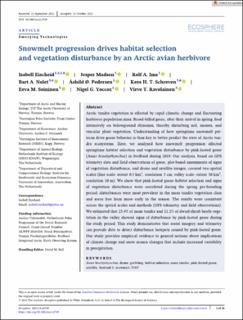| dc.contributor.author | Eischeid, Isabell | |
| dc.contributor.author | Madsen, Jesper | |
| dc.contributor.author | Ims, Rolf Anker | |
| dc.contributor.author | Nolet, Bart A. | |
| dc.contributor.author | Pedersen, Åshild Ønvik | |
| dc.contributor.author | Schreven, Kees H.T. | |
| dc.contributor.author | Soininen, Eeva Marjatta | |
| dc.contributor.author | Yoccoz, Nigel Gilles | |
| dc.contributor.author | Ravolainen, Virve | |
| dc.date.accessioned | 2024-01-17T15:04:25Z | |
| dc.date.available | 2024-01-17T15:04:25Z | |
| dc.date.created | 2023-12-18T12:35:27Z | |
| dc.date.issued | 2023-12-17 | |
| dc.identifier.citation | Ecosphere. 2023, 14 (12), . | en_US |
| dc.identifier.issn | 2150-8925 | |
| dc.identifier.uri | https://hdl.handle.net/11250/3112290 | |
| dc.description.abstract | Arctic tundra vegetation is affected by rapid climatic change and fluctuating herbivore population sizes. Broad-billed geese, after their arrival in spring, feed intensively on belowground rhizomes, thereby disturbing soil, mosses, and vascular plant vegetation. Understanding of how springtime snowmelt patterns drive goose behavior is thus key to better predict the state of Arctic tundra ecosystems. Here, we analyzed how snowmelt progression affected springtime habitat selection and vegetation disturbance by pink-footed geese (Anser brachyrhynchus) in Svalbard during 2019. Our analysis, based on GPS telemetry data and field observations of geese, plot-based assessments of signs of vegetation disturbance, and drone and satellite images, covered two spatial scales (fine scale: extent 0.3 km2, resolution 5 cm; valley scale: extent 30 km2, resolution 10 m). We show that pink-footed goose habitat selection and signs of vegetation disturbance were correlated during the spring pre-breeding period; disturbances were most prevalent in the moss tundra vegetation class and areas free from snow early in the season. The results were consistent across the spatial scales and methods (GPS telemetry and field observations). We estimated that 23.4% of moss tundra and 11.2% of dwarf-shrub heath vegetation in the valley showed signs of disturbance by pink-footed geese during the study period. This study demonstrates that aerial imagery and telemetry can provide data to detect disturbance hotspots caused by pink-footed geese. Our study provides empirical evidence to general notions about implications of climate change and snow season changes that include increased variability in precipitation. | en_US |
| dc.language.iso | eng | en_US |
| dc.publisher | Wiley Periodicals LLC on behalf of The Ecological Society of America | en_US |
| dc.rights | Navngivelse 4.0 Internasjonal | * |
| dc.rights.uri | http://creativecommons.org/licenses/by/4.0/deed.no | * |
| dc.title | Snowmelt progression drives habitat selection and vegetation disturbance by an Arctic avian herbivore | en_US |
| dc.type | Peer reviewed | en_US |
| dc.type | Journal article | en_US |
| dc.description.version | publishedVersion | en_US |
| dc.rights.holder | © 2023 The Authors | en_US |
| dc.subject.nsi | VDP::Økologi: 488 | en_US |
| dc.subject.nsi | VDP::Ecology: 488 | en_US |
| dc.source.volume | 14 | en_US |
| dc.source.journal | Ecosphere | en_US |
| dc.source.issue | 12 | en_US |
| dc.identifier.doi | 10.1002/ecs2.4729 | |
| dc.identifier.cristin | 2214823 | |
| dc.source.articlenumber | e4729 | en_US |
| cristin.ispublished | true | |
| cristin.fulltext | original | |
| cristin.qualitycode | 1 | |

